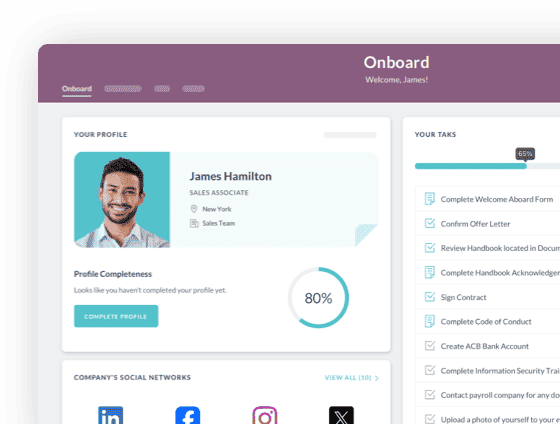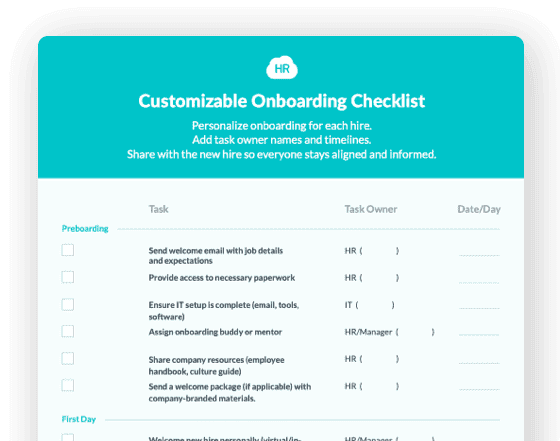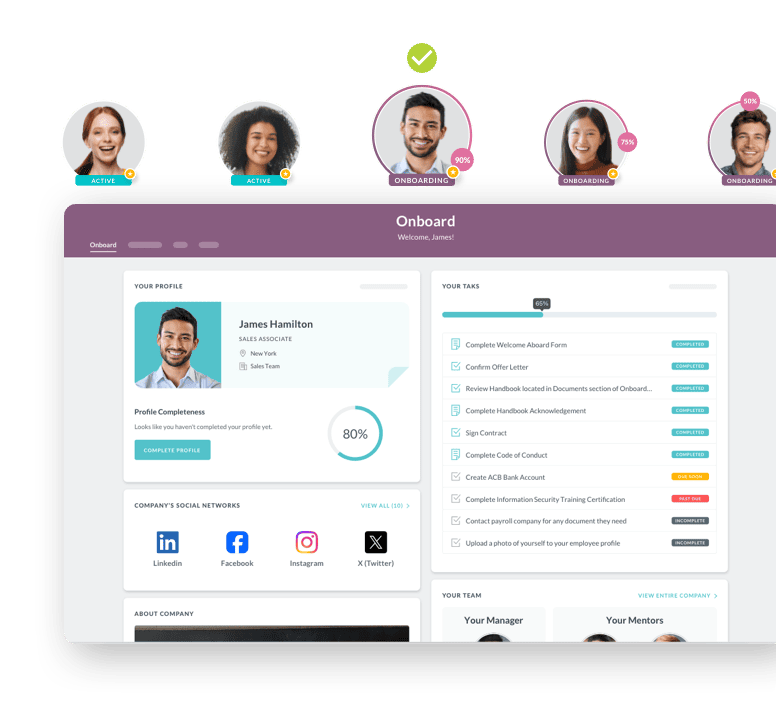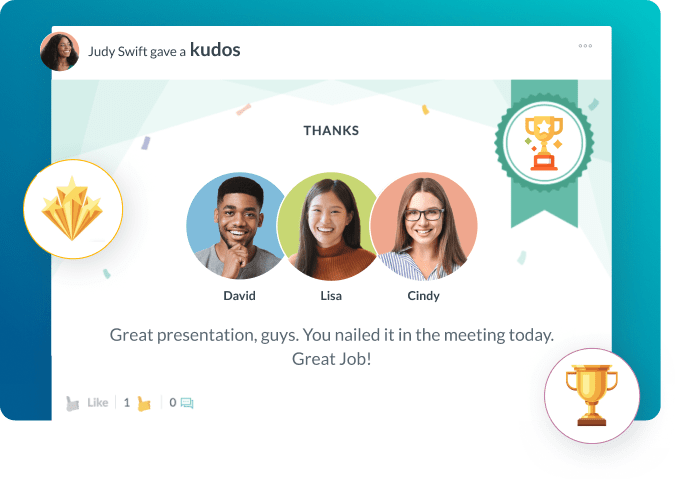Preboarding
- What Is Preboarding?
- Key Components of an Effective Preboarding Strategy
- A Value-Adding Comparison: Preboarding vs. Onboarding
- Best Practices for a Modern Preboarding Program
- Pitfalls to Avoid in Your Preboarding Strategy
- Industry Application: Why Preboarding Matters Across Sectors
- The Implementation Plan: A Step-by-Step Guide
- Future Outlook and Trends: The Evolution of Preboarding
- Preboarding, a Strategic Imperative

 Cut onboarding time
by 60%—here's the
Ultimate Checklist
that helped do it.
Cut onboarding time
by 60%—here's the
Ultimate Checklist
that helped do it.

What Is Preboarding?
Preboarding is the crucial period between a candidate accepting a job offer and their official first day of work. Often overlooked, this phase is a golden opportunity for businesses to transform a new hire's anxiety into genuine excitement and engagement. It's the first step in a strategic employee onboarding journey, where an organization can lay the groundwork for a successful and lasting professional relationship. A well-designed preboarding plan is essential for a smooth employee onboarding process.
Think of it as the welcome mat for your company culture. By engaging a new employee early, you're not just getting paperwork out of the way; you're actively demonstrating that you value them as a person, not just a resource. This proactive approach significantly reduces the risk of "ghosting"—when a new hire accepts an offer but fails to show up on their first day—and sets a positive tone that can lead to higher retention rates and faster productivity.
Key Components of an Effective Preboarding Strategy
A successful preboarding program is a thoughtful mix of practical tasks and cultural immersion. The goal is to make the new hire feel welcomed, prepared, and excited. Here are the key elements:
Communication is King:
The silence after an offer letter can be deafening. An effective preboarding strategy fills this gap with a series of well-timed, personalized communications. This can include a welcome email from their manager, a video message from the CEO, or a simple text message with a fun fact about the company. The key is to make the new hire feel seen and valued.
Administrative Streamlining:
The first day of a new job is overwhelming enough without a mountain of paperwork. A great preboarding experience digitizes and automates this process. By having new hires complete tax forms, benefits enrollment, and other documentation online before they start, you free up their first day for more meaningful activities like meeting the team and understanding their role. This can solve many of the common problems with onboarding new hires.
Equipment and System Access:
Nothing is more demotivating than showing up on day one without a computer, email access, or a desk. Preboarding ensures that IT and other departments have everything prepared in advance. This demonstrates organizational efficiency and respect for the new employee’s time.
Cultural Introduction:
Preboarding is the perfect time to introduce your company's mission, vision, and values. This can be done through a personalized welcome portal, an employee handbook, or even short video testimonials from current team members. This early exposure helps new hires understand the company's "why" and feel a part of the bigger picture.
A Value-Adding Comparison: Preboarding vs. Onboarding
While often used interchangeably, preboarding and onboarding are distinct phases of the employee lifecycle, each with a unique purpose. Preboarding is the sprint before the race begins, while onboarding is the marathon that follows.
|
Feature |
Preboarding |
Onboarding |
|
Time Frame |
The period between a signed offer letter and the first day. |
The first few weeks, months, or even the full year of employment. |
|
Primary Goal |
To build excitement, reduce anxiety, and handle logistical tasks before the start date. |
To fully integrate the new hire into the team, role, and company culture. |
|
Key Activities |
Sending welcome messages, completing paperwork digitally, setting up equipment, introducing the company culture. |
Job-specific training, performance management, mentor relationships, goal setting, team integration. |
|
Ownership |
Often driven by HR and the hiring manager with administrative support. |
A collaborative effort involving HR, the manager, and the entire team. |
|
Metrics for Success |
High offer acceptance rates, low new hire "ghosting," positive feedback on the welcome process. |
High employee engagement, increased productivity, low turnover rates after 90 days or one year. |
Best Practices for a Modern Preboarding Program
Implementing a successful preboarding strategy goes beyond a simple checklist. It requires a thoughtful, human-centric approach. For more information, you can find a guide to onboarding best practices on the HR Cloud blog.
-
Start Early and Stay Engaged:
-
Don’t wait until a week before their start date. Begin the preboarding process the moment the offer is accepted. Use a strategic drip campaign of emails and messages to maintain excitement without overwhelming the new hire.
-
Personalize the Experience:
-
Every new hire is unique. A generic, one-size-fits-all approach feels impersonal. Personalize communications with their name, role, and a note from their future manager. You can also offer tailored content, like a video tour of their department or an introduction to a mentor with a similar background. You can achieve this at scale with smart HR software, as seen in the solutions offered by HR Cloud.
-
Use Technology to Simplify:
-
The best preboarding programs leverage technology to automate repetitive tasks. From digital forms with e-signatures to an employee self-service portal, tools can streamline the process and allow HR to focus on the human element.
-
Assign a Buddy:
-
Connect the new hire with a peer mentor or "buddy" before their first day. This person can answer small questions (e.g., "What's the dress code?") and help them feel more comfortable and connected to the team from the very beginning. This practice has been shown to significantly boost new hire satisfaction.


Pitfalls to Avoid in Your Preboarding Strategy
Even with the best intentions, a preboarding program can fail if you fall into common traps.
The "Silent Period":
The most dangerous pitfall is radio silence between the offer and the start date. This creates an anxious period where the new hire might second-guess their decision or be lured away by a competitor who is more engaged. This is a common problem with outdated applicant tracking system software that doesn't integrate with post-offer communications.
Information Overload:
While it's important to provide information, sending a new hire a dozen documents to read in one email is a recipe for disaster. Drip-feed information in manageable chunks.
Ignoring the Manager's Role:
The preboarding process isn't solely owned by HR. The hiring manager is the new employee's most important point of contact. Failing to involve them in sending a welcome message or preparing the team can make the new hire feel disconnected from their immediate team.
Promises You Can’t Keep:
Don't promise a welcome kit or a fully set-up desk if you can't deliver. Misleading a new hire can erode trust before their first day.
Industry Application: Why Preboarding Matters Across Sectors
Preboarding is not a niche HR trend; it's a strategic imperative with broad applications across industries.
Tech & IT:
In a highly competitive talent market, preboarding in the tech sector can focus on providing early access to developer tools, setting up Slack channels, and introducing new engineers to their project teams. This helps them ramp up quickly and feel integrated into the fast-paced culture.
Healthcare:
For healthcare professionals, preboarding is critical for compliance and readiness. It can include sending policy documents, HIPAA training materials, and information about facility protocols so new hires are prepared to handle patient care from day one.
Retail & Hospitality:
With high turnover rates, preboarding in this sector is vital for creating a sense of belonging. It can involve sending a welcome video from the store manager, a staff directory, or information about the brand's history and values. This helps new employees feel connected to the brand and their colleagues. For multi-location businesses, an HRIS can help manage this process at scale.
The Implementation Plan: A Step-by-Step Guide
To launch a successful preboarding program, follow these steps:
Map the Journey:
-
Outline every touchpoint a new hire will have, from the moment they sign the offer to the end of their first week. This will reveal gaps and opportunities.
Gather the Resources:
Identify all the documents, videos, and materials needed for the program. This includes welcome letters, IT checklists, and benefit information.
Choose the Right Tools:
Invest in a platform that can automate communications, manage checklists, and provide a single source of truth for new hire information. An all-in-one HR platform with robust onboarding automation is an invaluable asset. You can even see HR Cloud's Onboard product in action with a demo.
Communicate with Stakeholders:
Get buy-in from hiring managers, IT, and other departments. Ensure they understand their role in the preboarding process and have the resources to fulfill their responsibilities.
Measure and Refine:
Launch a new hire survey to gather feedback on the preboarding experience. Use this data to continuously improve your program, making it more effective with each new hire.
Future Outlook and Trends: The Evolution of Preboarding
As the workplace continues to evolve, so too will preboarding. The future will be defined by personalization, automation, and a greater emphasis on the employee experience. We can expect to see:
AI-Powered Personalization:
Artificial intelligence will enable HR teams to create hyper-personalized preboarding experiences at scale. AI could recommend a personalized learning path based on the new hire's role or suggest a peer mentor with a similar background or interest.
Virtual and Immersive Experiences:
With the rise of remote and hybrid work, virtual reality (VR) and augmented reality (AR) could become part of the preboarding process. Imagine a virtual tour of the office or a simulated team meeting before day one. This trend is already gaining traction, as noted by Forbes.
Proactive Well-being Support:
Preboarding will go beyond professional development to include a focus on employee well-being. Companies will offer resources on mental health, remote work best practices, and work-life balance even before the new hire's first day. Gallup research highlights the direct link between a positive employee experience and engagement.
Preboarding, a Strategic Imperative
Preboarding is no longer a "nice-to-have" but a fundamental component of a modern talent management strategy. By focusing on engagement, communication, and efficiency in the critical period before day one, businesses can significantly improve their retention rates, boost productivity, and build a strong, lasting culture. A great preboarding experience is a powerful indicator of a company’s long-term commitment to its employees and sets the stage for a positive and productive journey.
Keep Reading
Night Shift, Float Pool, PRN: Onboarding Non-Traditional Nursing Schedules
Most nurse onboarding programs assume everyone works 9-to-5. Your carefully designed
Onboarding Home Health and Community Care Teams Who Never See the Main Office (The Tether Strategy)
You hire them on Monday. They see their first patient on Tuesday. And you might not see
Credential Tracking in Healthcare: How to Automate License Renewals and Stay Audit-Ready
A nurse shows up ready for her shift but her license expired yesterday. You scramble for
Ready to streamline your onboarding process?
Book a demo today and see how HR Cloud can help you create an exceptional experience for your new employees.







